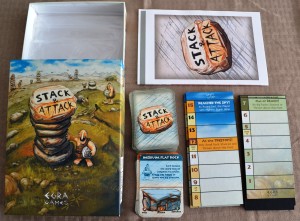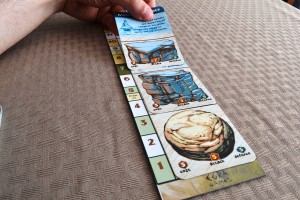Ahhhh, the caveman days…such simpler times. All we ever had to ever worry about was starting fires, inventing the wheel, and keeping those darned “Fruity Pebbles” away from Barney. Simple is exactly what “Stack & Attack” shoots for, setting its sights on audiences who love strategic games wrapped around casual themes. In this particular instance, “Stack & Attack” is a casual deck-builder game that tasks players with building a rock tower. Players will be endeavouring to build their own towers while at the same time, attempting to impede the progress of their opponents’ towers. Before we start throwing rocks at one another, I’d like to thank Chris Finlayson for reaching out to me and providing me with a free preview copy. It’s important to note that the game will be launching soon on Kickstarter (as of 9/7/13), so it goes without saying that the pictures and rules included in this article are subject to change.
Editor’s Note: The box indicated 3-4 players, but there is a two player variant listed in the manual.
The game itself consists of cards and separate player score tracks. Cards come in a variety of different styles, but all of them play a part in assisting players with building their tower. Rock cards can be used for both tower destruction (offense) and tower construction (victory condition), while effect cards buff/debuff players appropriately. Rock cards fit on the player score tracks, effectively allowing folks to keep track of how far along a particular tower is. Rocks are either flat or round, the former favoring defense (construction) and the latter favoring offense (attacking). The winner of the game is the first person who constructs a tower fifteen “arms” tall, or whoever has the highest tower when the quarry deck runs out.
Like “Dominion”, all of the players will start off with a particular predetermined deck. Using these cards, players will able to purchase more cards from the quarry to add to their deck. At the end of a player’s turn, they’ll then be able to incorporate the purchased cards into their deck to be used at a future date. As player decks increase in size, the more abilities they’ll have to use. What cards players choose to purchase ultimately affects what kind of abilities they’ll have. For those of you familiar with deck-builders in general, this is nothing new.
Unlike most deck-builders however, players will be required to shuffle their discard pile into their deck at the end of EVERY turn. This is a far cry from the norm, as most of the deck-builders I’ve played simply lets the deck run out before a reshuffle is required. I found that this definitely added a strategic element to the game, as the more cards you have, the less chance you have of getting the cards you are looking for at the time. With regular deck-builder rules, it isn’t a question of “if” you are getting the card you want, but “when”. Not so in this case. This mechanic worked well for the “Star Trek: The Next Generation Deck-Building Game” and it serves this game equally as well.
Also different is the way the quarry behaves. With “Dominion”, you have access to the entire “store” so to speak and buying the more expensive cards was only dependent on whether or not you could afford them. Rather than having a “store” with all of the cards displayed, only five are drawn at a time. As players buy cards from the stock, new cards are drawn from the deck to replace them. This took some getting used to, but I appreciated the strategic value behind it. With “Dominion”, I knew I had access to particular cards when I needed them. “Stack & Attack” forces players to make some hard choices and balance their wants with what they truly need to succeed.
Speaking of hard choices, the game features this gameplay element in abundance. Players will only have four action points to use on their turn, so they’ll need to decide whether to focus on attacking, building, buying cards, or opt for a combination of the three. Constructing your tower isn’t as simple as just plopping down rocks willy-nilly…you’ll need to account for rock size as certain sizes aren’t stackable once your tower reaches a certain height. Ideally, the large flat rocks make for a great tower base, though you may not have a choice in the matter and be forced to use small/medium rocks to stay competitive. One aspect that I found cool was that you earned new abilities as you construct your tower…more action points, a larger hand limit, that sort of thing. You can also target specific rocks on an opponent’s tower, but you’ll have to include the defense values of all rocks above the one you’re attempting to knock down.
Overall, the kids and I enjoyed our time with the game. “Stack & Attack” prides itself on being simple to learn, and I couldn’t agree more. Vinnie, who is only twelve years of age, was stacking rocks faster than I could say, “Zug Zug”. Not only is this game an excellent way to bring newcomers into the deck-building genre, it’s flexible and simple enough to introduce to gamers of most ages and types. The art is well done and themed appropriately while the manual I received laid everything out in an organized manner. Advanced rules exist for those who want more or less of a challenge, giving the game added replay value. It won’t appeal to those who dislike casual strategy games that incorporate direct attack mechanics, but families and gamers who emphasize fun over points will most likely love it. All in all, “Stack & Attack” is a fantastic and easy-to-play deck-builder that you won’t want to miss.
—
You can learn more about and support the game via the below links:
http://www.kickstarter.com/projects/egragames/stack-and-attack-a-rockin-card-stacking-game
http://boardgamegeek.com/boardgame/142043/stack-and-attack
http://boardgamegeek.com/filepage/92764/stack-attack-rules-version-3-7



